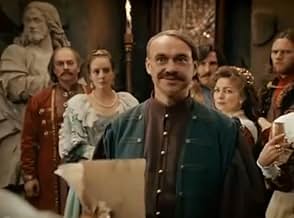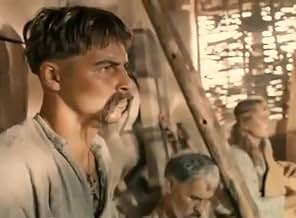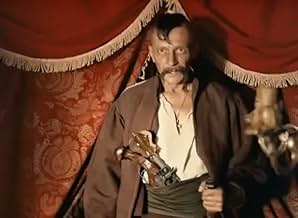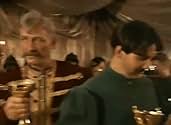Füge eine Handlung in deiner Sprache hinzuOne of the most difficult and tragic moments of the liberation war of Ukrainian people against the rule of Poland (1648-1657).One of the most difficult and tragic moments of the liberation war of Ukrainian people against the rule of Poland (1648-1657).One of the most difficult and tragic moments of the liberation war of Ukrainian people against the rule of Poland (1648-1657).
Vladimir Abazopulo
- Bohdan-Zinoviy Khmelnitzkiy
- (as Volodymyr Abazopulo)
Sergey Dzhigurda
- King Jan Kazimir
- (as Serhii Dzhyhurda)
Bilyal Bilyalov
- Khan Islam Girey III
- (as Bilial Bilialov)
Viktor Kruchina
- Prince Jeremi Wisniowiecki
- (as Viktor Kruchyna)
Nikolay Boklan
- Danylo Nechai
- (as Mykola Boklan)
Vitali Rosstalnoy
- Hetman Pototskyi
- (as Vitalii Rozstalnyi)
Taras Denisenko
- Morozenko
- (as Taras Denysenko)
Mikhail Konechnyy
- Cossack colonel
- (as Mykhailo Konechnyi)
Martina Jagodkina
- Olena
- (as Maryna Jahodkina)
Valeriy Sheptekita
- Bandurist
- (as Valerii Sheptekita)
Aleksey Vertinskiy
- Ivan Bohun
- (as Oleksii Vertynskyi)
Georgiy Khostikoev
- Shliakhtych
- (as Heorhii Khostikoiev)
Handlung
Ausgewählte Rezension
By the mid-seventeenth century the Polish Empire's eastern lands included most of today's Lithuania, Belarus and the Ukraine. Polish rule was harsh. Lands were expropriated, their owners reduced to serfdom. The Ukrainian language and the Orthodox Church were suppressed.
Bohdan Zinoviy Mykhaylovych Khmelnytsky was a member of the Ukrainian lesser nobility, a registered Cossack, and a minor official in the Polish administration. He suffered expropriation of some of his lands by a Polish nobleman. Khmelnytsky joined the Zaporozhian Cossacks, a semimilitary community of free men that had settled along the Dnieper River (Zaporozhye means "beyond the rapids"). He was elected as their supreme leader (hetman) and organized a rebellion in combination with the Crimean Tatars. His insurrection was supported by the dissatisfied peasants, townspeople, and clergy of Ukraine, who joined him in a mass uprising, which resulted in the slaughter of thousands of Polish lords. He reached the boundaries of Poland proper and took Lwów (now Lviv) in October 1648.
Khmelnytsky made peace with the new Polish King, John II Casimir, the terms agreed in the Compact of Zborów (August 1649). The King, however, did not comply with his side of the treaty so Khmelnytsky renewed the war in 1651. He suffered some military reverses and sought the aid of Alexsey, tsar of Russia (the Pereyaslav Agreement, January 1654). This resulted in direct Russian intervention.
Khmelnytsky is venerated as a hero in today's Ukraine; there are numerous memorials including a grand equestrian statue in Sophia Square, Kiev. There is also a city named after him. However, some Ukrainians have reservations, since his alliance with Russia was the beginning of the centuries-long incorporation of Eastern Ukraine into the Russian Empire. Not surprisingly Russians have a positive view of Khmelnytsky; there is a bridge with his name over the Moskva River in Moscow.
The main reason to watch this movie is visual. The costumes, props and scenery are excellent. All the characters speak in the language they are supposed to speak, Ukrainian, Polish, or Tatar. Acting is good (sometimes tending to the declamatory). Battle senes are stirring. Music includes some haunting Ukrainian folk songs. On the negative side, there is a certain uniformity in the storytelling (no salient points) and the profusion of characters is sometimes difficult to keep track of.
For the a view of the Khmelnytsky uprising from the Polish side, watch Jerzy Hoffman's With Fire and Sword (1999), based on a novel by Polish writer Henryk Sienkiewicz. There is also a Soviet take, Bohdan Khmelnytsky (1941) by Igor Savchenko.
Bohdan Zinoviy Mykhaylovych Khmelnytsky was a member of the Ukrainian lesser nobility, a registered Cossack, and a minor official in the Polish administration. He suffered expropriation of some of his lands by a Polish nobleman. Khmelnytsky joined the Zaporozhian Cossacks, a semimilitary community of free men that had settled along the Dnieper River (Zaporozhye means "beyond the rapids"). He was elected as their supreme leader (hetman) and organized a rebellion in combination with the Crimean Tatars. His insurrection was supported by the dissatisfied peasants, townspeople, and clergy of Ukraine, who joined him in a mass uprising, which resulted in the slaughter of thousands of Polish lords. He reached the boundaries of Poland proper and took Lwów (now Lviv) in October 1648.
Khmelnytsky made peace with the new Polish King, John II Casimir, the terms agreed in the Compact of Zborów (August 1649). The King, however, did not comply with his side of the treaty so Khmelnytsky renewed the war in 1651. He suffered some military reverses and sought the aid of Alexsey, tsar of Russia (the Pereyaslav Agreement, January 1654). This resulted in direct Russian intervention.
Khmelnytsky is venerated as a hero in today's Ukraine; there are numerous memorials including a grand equestrian statue in Sophia Square, Kiev. There is also a city named after him. However, some Ukrainians have reservations, since his alliance with Russia was the beginning of the centuries-long incorporation of Eastern Ukraine into the Russian Empire. Not surprisingly Russians have a positive view of Khmelnytsky; there is a bridge with his name over the Moskva River in Moscow.
The main reason to watch this movie is visual. The costumes, props and scenery are excellent. All the characters speak in the language they are supposed to speak, Ukrainian, Polish, or Tatar. Acting is good (sometimes tending to the declamatory). Battle senes are stirring. Music includes some haunting Ukrainian folk songs. On the negative side, there is a certain uniformity in the storytelling (no salient points) and the profusion of characters is sometimes difficult to keep track of.
For the a view of the Khmelnytsky uprising from the Polish side, watch Jerzy Hoffman's With Fire and Sword (1999), based on a novel by Polish writer Henryk Sienkiewicz. There is also a Soviet take, Bohdan Khmelnytsky (1941) by Igor Savchenko.
Top-Auswahl
Melde dich zum Bewerten an und greife auf die Watchlist für personalisierte Empfehlungen zu.
Details
- Erscheinungsdatum
- Herkunftsland
- Sprache
- Auch bekannt als
- Богдан-Зиновій Хмельницький
- Weitere beteiligte Unternehmen bei IMDbPro anzeigen
Box Office
- Budget
- 12.000.000 UAH (geschätzt)
- Laufzeit1 Stunde 58 Minuten
- Farbe
Zu dieser Seite beitragen
Bearbeitung vorschlagen oder fehlenden Inhalt hinzufügen

Oberste Lücke
By what name was Bohdan-Zynoviy Khmelnytskyi (2008) officially released in Canada in English?
Antwort























